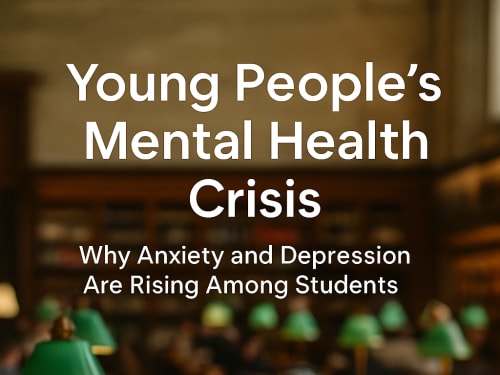Young People’s Mental Health Crisis: Why Anxiety and Depression Are Rising Among Students

posted 2nd October 2025

🌍 Young People’s Mental Health Crisis: Why Anxiety and Depression Are Rising Among Students
In the UK, student mental health problems have nearly tripled in just six years. Anxiety, stress, and depression are no longer rare struggles — they’ve become part of daily life for many young people. Recent figures show that almost one in four young people in England now lives with a common mental health condition. That’s a dramatic rise compared to just a decade ago.
So, what’s driving this crisis? From financial worries and relentless academic pressure to social media overload and the lingering impact of the pandemic, today’s students are facing challenges that don’t arrive one at a time — they collide, creating a perfect storm for mental health difficulties.
📑 What the Evidence Shows
The numbers tell a clear story: student mental health is not just an occasional concern — it’s a growing crisis.
- A study across UK universities found that 37.2% of female students and 16.7% of male students screened positive for depression. Rates of anxiety were even higher, with nearly half of female students (45.7%) affected compared to 16.7% of males (Elmacıoğlu et al., 2021).
- In first-year students, mental health often declines further: 28% reported depression and 33% anxiety at entry, rising to 36% and 39% by the end of the year (Richardson et al., 2020).
- Across the sector, student mental health problems have almost tripled in just six years, rising from 6% in 2016/17 to 16% by 2022/23 (TASO, 2023).
- Compared to non-students of the same age, those in higher education report slightly higher rates of anxiety and depression (Lewis et al., 2023).
- Encouragingly, universities that introduced well-being advisers (non-clinical staff supporting students) saw reductions in stress and improved resilience in the short term (Yamaguchi et al., 2024).
The data is clear: young people are struggling, but evidence also shows that targeted support can make a real difference.
💡 Why Student Mental Health Is Declining
So, why are students struggling more than ever? The answer lies in a mix of modern pressures that keep piling up:
- Financial stress 💷– Rising living costs, tuition fees, and debt create constant worry.
- Academic demands 📚 – Heavy workloads, competitive environments, and fear of failure fuel anxiety.
- Social media overload📱 – Constant comparison to “perfect lives” increases insecurity and keeps students mentally switched on 24/7.
- Pandemic aftershocks 😷 – Lockdowns disrupted education, social lives, and confidence in the future.
- Uncertain futures🌍 – Job market instability, climate change, and global crises add to feelings of hopelessness.
Individually, these are challenging. Together, they create a perfect storm of stress that drives anxiety and depression among today’s students.
🎓 The Consequences of Poor Mental Health for Students
When mental health difficulties go unchecked, the impact spreads far beyond emotions.
- Academic performance drops📉 – Anxiety and depression impair focus, memory, and motivation, leading to missed deadlines and lower grades.
- Higher dropout risk🚪 – Students with poor mental health are significantly more likely to withdraw from university.
- Strained relationships 💔 – Mental health challenges can weaken friendships, romantic relationships, and family ties.
- Physical health suffers🩺 – Problems like poor sleep, fatigue, and unhealthy coping strategies (e.g. drinking, emotional eating) often follow.
The ripple effects show that poor mental health isn’t just about feeling low — it can alter every part of a student’s life.
🌿 What Can Help: Coping and Support
The good news? There are effective ways to protect and improve student mental health.
- University support services 🤝 – Counselling, wellbeing advisers, and peer support groups are increasingly available.
- Healthy coping strategies 🧠 – Sleep, balanced routines, regular exercise, and breathing techniques all reduce stress.
- Peer connection👥 – Talking to friends, joining societies, and building community fights isolation.
- Professional help 🗨️ – Therapy, CBT, or GP support can provide long-term tools for managing anxiety and depression.
- Digital tools 📱 – Apps for mindfulness, journaling, or mood-tracking give students accessible support day-to-day.
Most importantly, struggling students need to hear this message: you are not alone. Reaching out is a sign of strength.
📚 References
Elmacıoğlu, F., Emiroğlu, E., Ünal, S., Özçelik, A. O., & Uçar, A. (2021). Emotional eating and negative emotional eating among university students: The role of gender. BMC Public Health, 21(1), 399. https://doi.org/10.1186/s12889-021-10531-3
Lewis, G., et al. (2023). Association of higher education with common mental disorder risk: A longitudinal cohort study. The Lancet Public Health, 8(2), e109–e118. https://doi.org/10.1016/S2468-2667(22)00269-2
Richardson, T., et al. (2020). Mental health of UK university students in the first year: The role of academic and non-academic stressors. BMC Psychiatry, 20, 244. https://doi.org/10.1186/s12888-020-02633-3
TASO (Transforming Access and Student Outcomes in Higher Education). (2023). Student mental health problems have almost tripled, study finds. Retrieved from https://taso.org.uk/news-blog/student-mental-health-problems-have-almost-tripled-study-finds/
Yamaguchi, S., et al. (2024). Well-being adviser programmes in UK universities: A new approach to non-clinical student mental health support. BMC Public Health, 24, Article 501. https://doi.org/10.1186/s12889-024-16043-5




